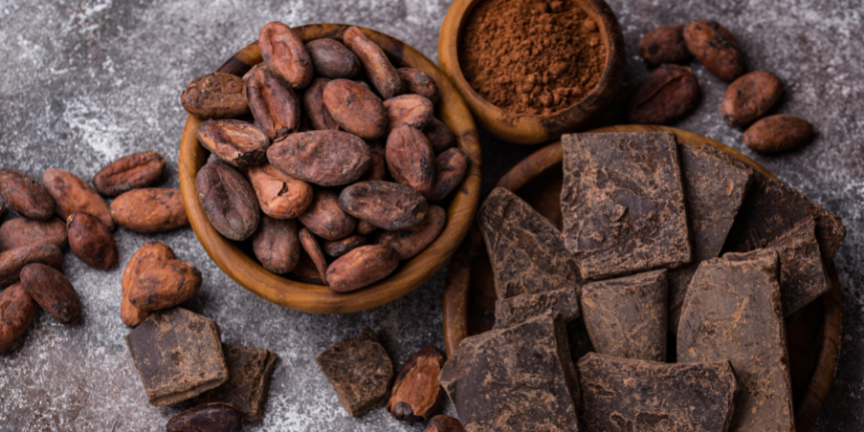Can chocolate be healthy?

We love eating chocolate! Some are more fond of white, others of milk, some of the windowed kind and others of the dark, expensive kind. There is another chocolate way that is not so obvious. Today you’ll read about drinking cocoa, not just any cocoa, because it’s non-fat, low-processed, whose properties will surprise you!
Let’s start with…. tree! Cocoa tree.
There are very few native cocoa trees left. The two varieties that can still be found are:
- Chuncho (native to Peru).
- and Criollo (native to Guatemala, but also grows in Venezuela).
95% of the industry, however, are trees modified and adapted by man. Chocolates are created from Forastero, Trinitario and CN51 varieties.
Why am I writing this? Because you have to realise that these 95% cocoa are of inferior quality in terms of cocoa characteristics, they are produced to harvest as many cocoa beans as possible from a single tree. Logical, right?
So how is the processing of the seeds to make non-fat cocoa different from the seeds for chocolate?
Each cocoa seed is fermented and then dried (this is how non-fat cocoa is made).
When it comes to mass-produced seeds for crunching they are usually from cacao hybrids, meaning the amount of nutrients will be lower.
To make dark chocolate it is the seeds that will be made into a paste and subjected to tempering, which means heating and cooling the paste for hours. This is why the chocolate is not opaque. Many of the compounds will survive tempering, so eating dark chocolate (80% and above) will also be a good idea.
As for milk chocolate, on the other hand… Hm. The cocoa content is about 30%, the rest is milk, sugar and additives. The zoonotic milk will inhibit the absorption of the flavonoids, which means that we are supposedly eating something nice, but we are not quite able to benefit from it. I leave the choice up to you.
Properties of cocoa
And this is where I hope to positively surprise you, because drinking cocoa can increase brain oxygenation by up to 30% and improve your cognitive abilities.
How does this happen?
Theobromine
The theobromine in cocoa, unlike the caffeine in coffee, does not stimulate the nervous system but dilates the blood vessels that improve blood flow. And if a greater volume of blood reaches our entire body, this increases oxygenation and nutrients throughout our body.
Serotonin
Tryptophan is a very important amino acid in the production of serotonin. Serotonin is known as the ‘happy hormone’. It is the neurotransmitter responsible for feelings of happiness, bliss and relaxation. It improves our mood. On top of that, it comes with.
Dopamine
Phenylethylamine in cocoa is another amino acid that stimulates the brain to secrete, among other things, dopamine. What does this mean? Dopamine can be called the ‘energy, pleasure and motivation hormone’. In addition, it stimulates the reward centre in our brain. After drinking cocoa, you want more, what you are doing seems more important and enjoyable, and the reward centre reminds you that it is worth doing.
It doesn’t stop there. The same phenylethylamine has a nootropic effect, meaning it increases the cognitive function of the brain, meaning you learn better, perform better at problem solving and increase your level of focus on a specific task.
And much more
In cocoa, you’ll find lots of flavanols, which reduce blood pressure, support pancreatic function, regulate obesity and help you feel good.
You’ll also find anandamides, which help you feel satiety and hunger, control lipid and carbohydrate metabolism, support the liver and pancreas and give you a sense of relaxation.
Cocoa is also a great source of magnesium, iron, calcium and copper!
And in addition, it contains 40-60% fat. It’s quite a treat for fans of the ketogenic diet!
Would you like to try cacao?
If you want to try cacao from native varieties then I recommend
- Prawdziwe kakao, where you can find 59% fat cocoa,
- CHOC chick, where you can find powder, 13% fat cocoa.
How do you prepare such cocoa?
If you want to drink it every day then I recommend small doses of 5 – 20g (I drink a tablespoon of cocoa every day). The powdered cocoa is simply poured over boiling water, while the lump cocoa needs to be scraped with a knife or vegetable peeler and either poured over boiling water and blended, or poured into a pot and boiled for 5min.
You can also drink doses of so-called ceremonial 36 – 80g 1 to 3 times a week. These are doses that strongly enhance cognitive abilities, but every body will react a little differently to them (I suggest trying them at the weekend).
To reduce the bitterness of cocoa, you can make it with plant milk and honey. Zoonotic milk is not recommended as it blocks the absorption of flavonoids in the gut.
Contraindications to drinking cocoa
- taking antidepressants (tryptophan and MAO inhibitors act synergistically and should not be combined),
- irritable bowel syndrome (there is a correlation of elevated serotonin levels with irritable bowel syndrome),
- heart disorders and taking medication for high blood pressure (theobromine dilates blood vessels).
And if you are counting calories I recommend the Fitatu app!
Download the application from the Play Store or Apple Store and start counting your macros with us!
Do you prefer the web version? No problem. A basic web version is prepared for our subscribers. And now you can use the CHOC-5 discount code by going to https://www.fitatu.com/app/giftcode and get 29% off your monthly Fitatu Premium.
What else can you find in Fitatu Premium?
- over 1000 recipes plus several new ones every month
- additional plans for intermittent fasting
- the ability to create shopping lists
- a choice of six ready-made menus full of meals to choose
- filtering products and recipes
- more synchronization with fit apps
- access to the application in the web version
- no ads!





